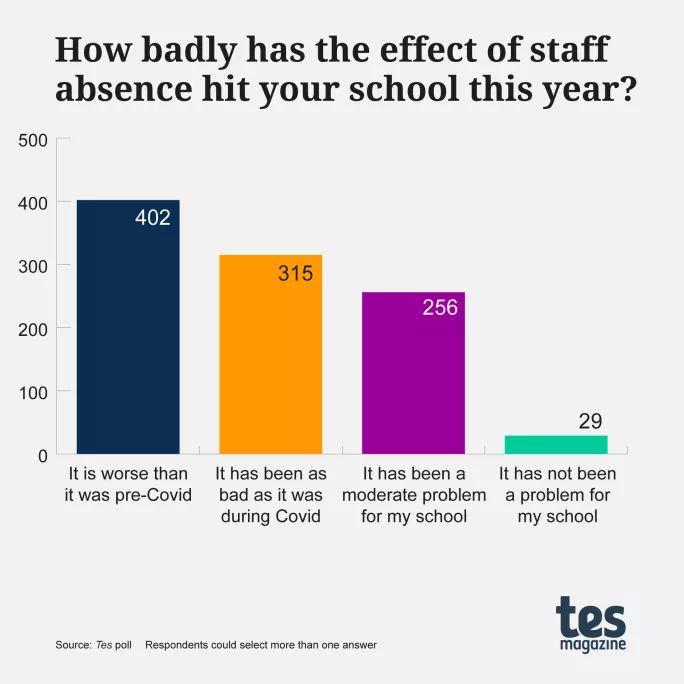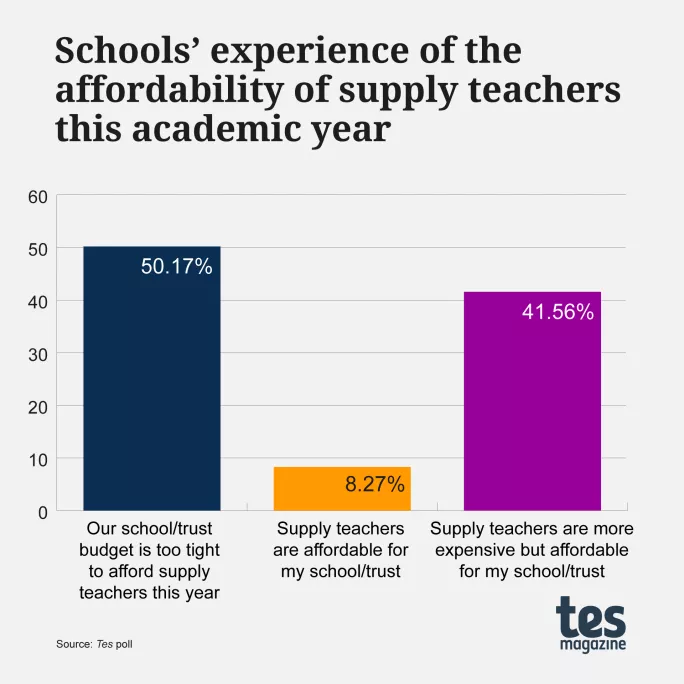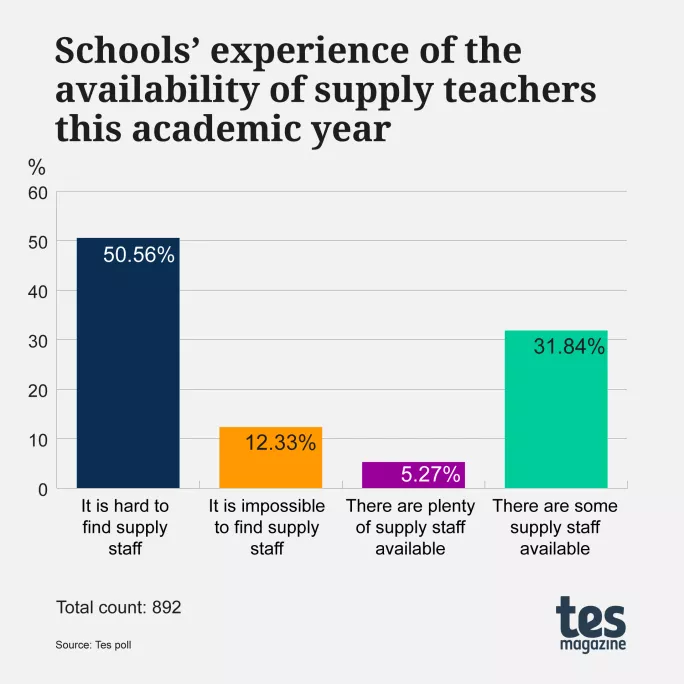4 in 10 say staff absence worse than before pandemic

Staff absence has got worse since the pandemic, with higher levels than before Covid, according to four in ten school staff who took part in a Tes survey.
Teachers and heads warn that staff absence is “worse than ever” and causing “unsustainable” pressure in schools as stretched budgets and a worsening recruitment crisis push the workforce beyond its limits.
The survey reveals the impact of higher levels of illnesses, such as flu and scarlet fever, in addition to Covid, circulating in schools this winter, forcing them to employ pandemic-style measures to plug staffing gaps.
Schools have been forced to merge classes, prioritise year groups and use cover supervisors due to the scarcity and lack of funding to afford supply teachers, according to headteachers, teachers and other school staff who took part in the survey.
- Pupil attendance: MPs to launch persistent absence inquiry
- Background: Over 5,800 teachers and support staff off because of Covid
- Mental health: Half of teachers ‘suffering burnout’ during Covid
Almost a third of respondents (31 per cent) said staff absence has been as bad this year as it was during the pandemic when schools were fully open, according to the exclusive Tes poll of more than 1,000 teachers, leaders and other school staff.

The survey also underlined the more acute impact that rising staff absence has had in special schools, where specially trained supply workers are tougher to find.
More than eight in 10 of respondents working in special schools said it was either hard or impossible to find supply staff.
This was much higher than the overall figure of 63 per cent across all settings.

The figure was drawn from 80 respondents working in special schools across the country.
Across all settings, just 5.3 per cent of respondents said that there was plenty of supply staff available.
Even where supply staff are available, more than half (50.2 per cent) of staff said their school or trust budget was “too tight” to afford supply teachers this year.
More than four in ten (41.6 per cent) said that supply teachers are more expensive but affordable, while just 8.3 per cent said supply teachers were affordable.

Merged classes
The high levels of staff off sick have forced schools to change timetables and the way lessons are taught to ensure learning can still go ahead.
More than four in 10 (44 per cent) of the respondents to a Tes survey said they are using cover supervisors, while 34.9 per cent are having to merge two or more classes, while 4.8 per cent have had to move classes to remote learning.

Warren Carratt, CEO of Nexus MAT and Evolve Trust, said that ”there is a huge amount of exhaustion in the system”.
He said that nearly 2,500 sick days had been lost across his 14 schools between the start of term and mid-January.
Mr Carratt added that issues had been “compounded” by a loss of teaching assistants or early retirement after the pandemic.
He said supply staff aren’t available “so, more often than not, it is about asking our existing staff to go the extra mile and stretch themselves”.
Geoff Barton, general secretary of the Association of School and College Leaders, said that school and college budgets were “extremely tight following years of government underfunding and a surge in staff absence this winter is likely to drain their supply budgets”.
Mr Barton added that this was “unsustainable but schools have to put teachers in front of classes so have few options available to them”.
He added: “A greater reliance on supply staff and non-subject specialists more generally is also a symptom of the growing number of vacancies in schools as a result of the long-term failure to address the recruitment and retention crisis.”
Leaders have also called for the reintroduction of the workforce fund in recent months to help with the costs of filling the gaps.
Vic Goddard, co-principal of Passmores Academy, said his school was forced to combine classes in the hall towards the end of the autumn term due to high levels of staff absence.
He said this was not something he had ever had to do before the pandemic.
Staff struggling more with behaviour
Respondents also said that staff wellbeing and morale were “at an all-time low with unrealistic expectations and workload.”
Some school staff who took part in the survey said that the nature of the work has become harder because of more challenging pupil behaviour, leading to “burnout” among staff.
One teaching assistant said that student behaviour was “terrible” and the pandemic appeared to have “deeply affected how they respond to authority and rules”, with little respect for staff.
One teacher even said that pupil behaviour was putting supply staff off returning to work in schools.
Earlier this week, a Department for Education report found that schools are being left to deal with a “tsunami of pressures” hitting pupils’ wellbeing, with children’s mental health struggling to recover post-pandemic.
Kevin Courtney, joint general secretary of the NEU teaching union, whose teacher members walked out in the first of a series of planned strike days over pay last week, said the survey results make “plain to see” the “government has failed to heed any of the alarm bells around the sustainability of staffing schools under the pressures of real-terms funding cuts, pay cuts against inflation, high workload, a recruitment and retention crisis, and the effects of the pandemic”.

Mr Courtney added that both teacher and support supply staff “play a vital part but they have been hard done by in recent years”.
He said: “Their daily pay rates remain low, significantly below that of someone in a full-time post. Many find they are employed as a cover supervisor only to be asked to act as a teacher on the cheap.
“To add insult to injury, agencies dominate the supply market and their commission punishes both school and supply staff in the pocket.
“The NEU continues to believe that a register system, which permits direct employment and which removes agencies as intermediaries, is a better solution.”
DfE should collect staff absence data
While the DfE does not publish staff absence data, its latest pupil absence data showed numbers rising again at the end of January after dipping following the Christmas break.
At the end of the autumn term, data showed that absence through illness in primary schools was as high as during the peak of the Omicron Covid wave.
Andy Byers, the headteacher of Framwellgate School in Durham, told Tes it would be useful if the DfE collected and published absence rates for staff as well as for pupils.
Mr Byers said: ”I don’t think anybody’s got any idea what the issues are that face us in relation to staff absence.”
While he said the collection of such data would be “another added workload” for schools, he thought staff would “happily put that information together if they felt it was being used”.
A Department for Education spokesperson said: “We continue to work with the sector to improve teacher wellbeing, including working with the charity Education Support to provide mental health and wellbeing support to school leaders.
“School leaders are best placed to determine the workforce required to meet the needs of pupils and in the first instance schools should follow their usual process for covering absences.”
Over 1,000 school staff responded to a survey run on the Tes magazine website between 25 January and 7 February 2023. 909 were current school leaders, teachers and other staff working in England
You need a Tes subscription to read this article
Subscribe now to read this article and get other subscriber-only content:
- Unlimited access to all Tes magazine content
- Exclusive subscriber-only stories
- Award-winning email newsletters
Already a subscriber? Log in
You need a subscription to read this article
Subscribe now to read this article and get other subscriber-only content, including:
- Unlimited access to all Tes magazine content
- Exclusive subscriber-only stories
- Award-winning email newsletters
topics in this article



